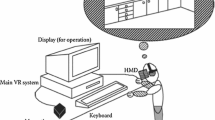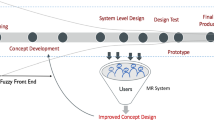Abstract
The paper deals with prototyping strategies aimed at supporting engineers in the design of the multisensory experience of products. It is widely recognised that the most effective strategy to design it is to create working prototypes and analyse user’s reactions when interacting with them. Starting from this consciousness, we will discuss of how virtual reality (VR) technologies can support engineers to build prototypes suitable to this aim. Furthermore we will demonstrate how VR-based prototypes do not only represent a valid alternative to physical prototypes, but also a step forward thanks to the possibility of simulating and rendering multisensory and real-time modifiable interactions between the user and the prototype. These characteristics of VR-based prototypes enable engineers to rapidly test with users different variants and to optimise the multisensory experience perceived by them during the interaction. The discussion is supported both by examples available in literature and by case studies we have developed over the years on this topic. Specifically, in our research we have concentrated on what happens in the physical contact between the user and the product. Such contact strongly influences the user’s impression about the product.







Similar content being viewed by others
References
Avanzini, F., Serafin, S., & Rocchesso, D. (2005). Interactive simulation of rigid body interaction with friction-induced sound generation. IEEE Transactions on Speech and Audio Processing, 13(5), 1073–1081. doi:10.1109/TSA.2005.852984.
Azuma, R., Baillot, Y., Behringer, R., Feiner, S., Julier, S., & MacIntyre, B. (2001). Recent advances in augmented reality. IEEE Computer Graphics and Applications, 21(6), 34–47. doi:10.1109/38.963459.
Azuma, R. T. (1997). A survey of augmented reality. Presence, 6, 355–385.
Bederson, B. B. (1995). Audio augmented reality: A prototype automated tour guide. In Conference companion on human factors in computing systems, ACM, New York, NY, USA, CHI ’95, pp. 210–211. doi:10.1145/223355.223526.
Bordegoni, M. (2011). Product virtualization: An effective method for the evaluation of concept design of new products. Innovation in product design (pp. 117–141). London: Springer.
Bordegoni, M., & Ferrise, F. (2013). Designing interaction with consumer products in a multisensory virtual reality environment. Virtual and Physical Prototyping, 8(1), 51–64. doi:10.1080/17452759.2012.762612.
Bordegoni, M., & Rizzi, C. (Eds.) (2011). Innovation in product design: From CAD to virtual prototyping. Berlin: Springer.
Bordegoni, M., Cugini, U., Caruso, G., & Polistina, S. (2009). Mixed prototyping for product assessment: A reference framework. International Journal on Interactive Design and Manufacturing, 3, 177–187.
Bordegoni, M., Ferrise, F., & Lizaranzu, J. (2011). Use of interactive virtual prototypes to define product design specifications: A pilot study on consumer products. In VR innovation (ISVRI), 2011 IEEE international symposium on (pp. 11–18).
Buchenau, M., & Suri, J. F. (2000). Experience prototyping. In Proceedings of the 3rd conference on designing interactive systems: Processes, practices, methods, and techniques (pp. 424–433). ACM.
Burdea, G. C., & Coiffet, P. (2003). Virtual reality technology (2nd ed.). New Jersey: Wiley-IEEE Press.
Chua, C. K., Leong, K. F., & Lim, C. S. (2010). Rapid prototyping: Principles and applications. Singapore: World Scientific.
Desmet, P. M. A., & Hekkert, P. (2007). Framework of product experience. International Journal of Design, 1(1), 57–66.
DIS I (2009) 9241-210: 2010. Ergonomics of human system interaction-part 210: Human-centred design for interactive systems. Switzerland: International Standardization Organization (ISO).
Farnell, A. (2010). Designing sound. Cambridge: MIT Press.
Ferrise, F., Bordegoni, M., & Lizaranzu, J. (2010). Product design review application based on a vision-sound-haptic interface. In R. Nordahl, S. Serafin, F. Fontana & S. Brewster (Eds.), Haptic and audio interaction design, Lecture Notes in Computer Science (Vol. 6306, pp. 169–178). Berlin, Heidelberg: Springer.
Ferrise, F., Bordegoni, M., & Cugini, U. (2013a). Interactive virtual prototypes for testing the interaction with new products. Computer-Aided Design and Applications, 10(3), 515–525.
Ferrise, F., Bordegoni, M., & Graziosi, S. (2013b). A method for designing users’ experience with industrial products based on a multimodal environment and mixed prototypes. Computer-Aided Design and Applications, 10(3), 461–474.
Forlizzi, J., & Battarbee, K. (2004). Understanding experience in interactive systems. In Proceedings of the 5th conference on designing interactive systems: Processes, practices, methods, and techniques (pp. 261–268). ACM.
Gallace, A., & Spence, C. (2013). In touch with the future. Oxford: Oxford University Press.
Gallace, A., Ngo, M. K., Sulaitis, J., & Spence, C. (2012). Multisensory presence in virtual reality: Possibilities & limitations. In G. Ghinea, F. Andres, & S. Gulliver (Eds.), Multiple sensorial media advances and applications: New developments in MulSeMedia (pp. 1–38). Hershey, PA: Information Science Reference. doi:10.4018/978-1-60960-821-7.ch001.
Graziosi, S., Ferrise, F., Bordegoni, M., Ozbey, O., et al. (2013). A method for capturing and translating qualitative user experience into design specifications: The haptic feedback of appliance interfaces. In DS 75-7: Proceedings of the 19th international conference on engineering design (ICED13), design for harmonies, Vol. 7: Human behaviour in design, Seoul, Korea, 19-22.08.
Graziosi, S., Ferrise, F., Phillips Furtado, G., & Bordegoni, M. (2014). Reverse engineering of interactive mechanical interfaces for product experience design. Virtual and Physical Prototyping, 9(2), 65–79.
Grunwald, M. (Ed.). (2008). Human haptic perception: Basics and applications (1st ed.). Basel, Boston, Berlin: Birkhäuser Basel.
Hainich, R. R., & Bimber, O. (2011). Displays: Fundamentals and applications. Boca Raton: A K Peters/CRC Press.
Hassenzahl, M. (2005). The thing and I: Understanding the relationship between user and product. In Funology (pp. 31–42). Netherlands: Springer.
Hassenzahl, M. (2010a). Experience design: Technology for all the right reasons. Synthesis Lectures on Human-Centered Informatics, 3(1), 1–95.
Hassenzahl, M. (2010b). Experiencing and experience. Interview–Generalist 4, 2010 issue on “Use and Habit”.
Hassenzahl, M., (2014). User experience and experience design. In M. Soegaard & R. F. Dam (Eds.), The encyclopedia of human-computer interaction (2nd ed.). Aarhus, Denmark: The Interaction Design Foundation.
Hassenzahl, M., & Tractinsky, N. (2006). User experience-a research agenda. Behaviour & Information Technology, 25(2), 91–97.
Hassenzahl, M., Eckoldt, K., Diefenbach, S., Laschke, M., Lenz, E., & Kim, J. (2013). Designing moments of meaning and pleasure experience design and happiness. International Journal of Design, 7(3), 21–31.
Hayward, V., Ashley, O., Hernandez, M. C., Grant, D., & Robles-De-La-Torre, G. (2004). Haptic interfaces and devices. Sensor Review, 24(1), 16–29.
Ishii, H., & Ullmer, B. (1997). Tangible bits: Towards seamless interfaces between people, bits and atoms. In Proceedings of the ACM SIGCHI conference on human factors in computing systems, ACM, New York, NY, USA, CHI ’97, pp. 234–241. doi:10.1145/258549.258715.
Jeon, S., & Choi, S. (2009). Haptic augmented reality: Taxonomy and an example of stiffness modulation. Presence: Teleoperators and Virtual Environments, 18(5), 387–408. doi:10.1162/pres.18.5.387.
Klatzky, R., & Peck, J. (2012). Please touch: Object properties that invite touch. IEEE Transactions on Haptics, 5(2), 139–147. doi:10.1109/TOH.2011.54.
Krishna, A., Lwin, M. O., & Morrin, M. (2010). Product scent and memory. Journal of Consumer Research, 37(1), 57–67.
Langeveld, L., van Egmond, R., Jansen, R., & Özcan, E. (2013). Product sound design: Intentional and consequential sounds. In D. Coelho (Ed.), Advances in industrial design engineering. http://www.intechopen.com/books/advances-in-industrial-design-engineering/product-sound-design-intentional-and-consequential-sounds.
Leithinger, D., Follmer, S., Olwal, A., Luescher, S., Hogge, A., Lee, J., & Ishii, H. (2013). Sublimate: State-changing virtual and physical rendering to augment interaction with shape displays. In Proceedings of the SIGCHI conference on human factors in computing systems, ACM, New York, NY, USA, CHI ’13, pp. 1441–1450. doi:10.1145/2470654.2466191.
Milgram, P., & Kishino, F. (1994). A taxonomy of mixed reality visual displays. IEICE Trans Information Systems, E77–D(12), 1321–1329.
Mugge, R., & Schoormans, J. P. (2012). Newer is better! The influence of a novel appearance on the perceived performance quality of products. Journal of Engineering Design, 23(6), 469–484.
Mynatt, E.D., Back, M., Want, R., & Frederick, R. (1997). Audio aura: Light-weight audio augmented reality. In Proceedings of the 10th annual ACM symposium on user interface software and technology, ACM, New York, NY, USA, UIST ’97, pp 211–212. doi:10.1145/263407.264218.
Nakamoto, T. (Ed.) (2013). Human olfactory displays and interfaces: Odor sensing and presentation. Hershey: IGI Global.
Narumi, T., Nishizaka, S., Kajinami, T., Tanikawa, T., & Hirose, M. (2011). Augmented reality flavors: Gustatory display based on edible marker and cross-modal interaction. In Proceedings of the SIGCHI conference on human factors in computing systems, ACM, New York, NY, USA, CHI ’11, pp. 93–102. doi:10.1145/1978942.1978957.
Nojima, T., Sekiguchi, D., Inami, M., & Tachi, S. (2002). The smarttool: A system for augmented reality of haptics. In Virtual reality, 2002. Proceedings (pp. 67–72). IEEE. doi:10.1109/VR.2002.996506.
Norman, D. (2004). Emotional design: Why we love (or hate) everyday things. New York: Basic Civitas Books.
Ottosson, S. (2002). Virtual reality in the product development process. Journal of Engineering Design, 13(2), 159–172.
Phillips Furtado, G., Ferrise, F., Graziosi, S., & Bordegoni, M. (2013). Optimization of the force feedback of a dishwasher door putting the human in the design loop. In A. Chakrabarti & R. V. Prakash (Eds.), ICoRD’13, Lecture Notes in Mechanical Engineering (pp. 939–950). India: Springer.
Pine, B. J., & Gilmore, J. H. (2011). The experience economy. Boston: Harvard Business Press.
Rocchesso, D., & Serafin, S. (2009). Sonic interaction design. International Journal of Human-Computer Studies, 67(11), 905–906.
Schifferstein, H. N., & Hekkert, P. (2011). Product experience. Amsterdam: Elsevier.
Schmitt, B. (1999). Experiential marketing. Journal of Marketing Management, 15(1–3), 53–67.
Shin, S,, Lee, I., Lee, H., Han, G., Hong, K., Yim, S., et al. (2012). Haptic simulation of refrigerator door. In Haptics Symposium (HAPTICS) (pp. 147–154). IEEE. doi:10.1109/HAPTIC.2012.6183783.
Spence, C., & Gallace, A. (2011). Multisensory design: Reaching out to touch the consumer. Psychology and Marketing, 28(3), 267–308. doi:10.1002/mar.20392.
Spence, C., & Zampini, M. (2006). Auditory contributions to multisensory product perception. Acta Acustica united with Acustica, 92(6), 1009–1025. http://www.ingentaconnect.com/content/dav/aaua/2006/00000092/00000006/art00020.
Spence, C., Puccinelli, N. M., Grewal, D., & Roggeveen, A. L. (2014). Store atmospherics: A multisensory perspective. Psychology & Marketing, 31(7), 472–488. doi:10.1002/mar.20709.
Strolz, M., Groten, R., Peer, A., & Buss, M. (2011). Development and evaluation of a device for the haptic rendering of rotatory car doors. IEEE Transactions on Industrial Electronics, 58(8), 3133–3140. doi:10.1109/TIE.2010.2087292.
Van der Auweraer, H., Wyckaert, K., & Hendricx, W. (1997). From sound quality to the engineering of solutions for nvh problems: Case studies. Acta Acustica united with Acustica, 83(5), 796–804.
Van Krevelen, D., & Poelman, R. (2010). A survey of augmented reality technologies, applications and limitations. International Journal of Virtual Reality, 9(2), 1.
Wang, G. G. (2002). Definition and review of virtual prototyping. Journal of Computing and Information Science in Engineering, 2(3), 232–236. doi:10.1115/1.1526508. http://link.aip.org/link/?CIS/2/232/1.
Zorriassatine, F., Wykes, C., Parkin, R., & Gindy, N. (2003). A survey of virtual prototyping techniques for mechanical product development. Proceedings of the Institution of Mechanical Engineers, Part B: Journal of Engineering Manufacture, 217(4), 513–530.
Author information
Authors and Affiliations
Corresponding author
Rights and permissions
About this article
Cite this article
Ferrise, F., Graziosi, S. & Bordegoni, M. Prototyping strategies for multisensory product experience engineering. J Intell Manuf 28, 1695–1707 (2017). https://doi.org/10.1007/s10845-015-1163-0
Received:
Accepted:
Published:
Issue Date:
DOI: https://doi.org/10.1007/s10845-015-1163-0




